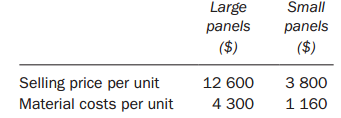Solar Systems Co (S Co) makes two types of solar panels at its manufacturing plant: large panels
Question:
Solar Systems Co (S Co) makes two types of solar panels at its manufacturing plant: large panels for commercial customers and small panels for domestic customers. All panels are produced using the same materials, machinery and a skilled labour force. Production takes place for five days per week, from 7 am until 8 pm (13 hours), 50 weeks of the year. Each panel has to be cut, moulded and then assembled using a cutting machine (Machine C), a moulding machine (Machine M) and an assembly machine (Machine A).As part of a government scheme to increase renewable energy sources, S Co has guaranteed not to increase the price of small or large panels for the next three years. It has also agreed to supply a minimum of 1000 small panels each year to domestic customers for this three-year period.Due to poor productivity levels, late orders and declining profits over recent years, the finance director has suggested the introduction of throughput accounting within the organization, together with a ?Just in Time? system of production. Material costs and selling prices for each type of panel are shown below.

Total factory costs, which include the cost of labour and all factory overheads, are $12 million each year at the plant. Out of the 13 hours available for production each day, workers take a one hour lunch break. For the remaining 12 hours, Machine C is utilized 85 percent of the time and Machines M and A are utilized 90 percent of the time. The unproductive time arises either as a result of routine maintenance or because of staff absenteeism, as each machine needs to be manned by skilled workers in order for the machine to run. The skilled workers are currently only trained to work on one type of machine each. Maintenance work is carried out by external contractors who provide a round-the-clock service (that is, they are available 24 hours a day, seven days a week), should it be required.The following information is available for Machine M, which has been identified as the bottleneck resource:

There is currently plenty of spare capacity on Machines C and A. Maximum demand for large panels and small panels is 1800 units and 1700 units respectively.
Required:(a) Calculate the throughput accounting ratio for large panels and for small panels and explain what they indicate to S Co about production of large and small panels.(b) Assume that your calculations in part (a) have shown that large panels have a higher throughput accounting ratio than small panels.Using throughput accounting, prepare calculations to determine the optimum production mix and maximum profit of S Co for the next year.(c) Suggest and discuss THREE ways in which S Co could try to increase its production capacity and hence increase throughput in the next year without making any additional investment in machinery.
Step by Step Answer:






